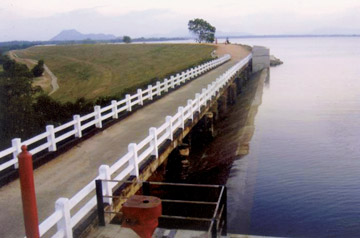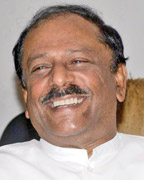Mega water projects get off the ground
By L.S. Ananda WEDAARACHCHI

Unnichchai Water intake |
 |
| Unnichchai
Water Tower, Batticaloa |
Water Supply schemes estimated to cost billion of rupees to provide
potable water to the people are being implemented islandwide, said
National Water Supply and Drainage Board Chairman (NWSDB) Eng.
Karunasena Hettiarachchi.
Water is an essential commodity for human life and providing
drinkable water to the people is a priority of any Government, he said.
The Sunday Observer interviewed the NWSDB Chairman on his ongoing
projects.
Excerpts of the interview:
Q: It was reported that scientific studies have identified
contaminated water to be the probable cause for the fast spreading
kidney decease in the North Central Province (NCP) and Uva Province.
Does the NWSDB have the wherewith all to ensure purified drinking
water to said provinces?
A: Major water supply projects and other small scale and
village based water supply projects have been designed to meet this
need.
Q: What are the major water supply projects in the NCP?
 |
 |
|
Unnichchai Water Tower, Batticaloa |
NWSDB Chairman Karunasena
Hettiarachchi |
A: There are 12 water supply projects such as Anuradhapura
South, Anuradhapura North, Mahavilachchiya, Padaviya, Galenbindunuweva,
Tambuttegama, Parasangahaweva, Viharapalugama, Eppawela, Welikanda and
Habarana. The Anuradhapura project estimated at Rs. 12,725 million will
benefit 139,500 people, while the Anuradhapura North project costing Rs.
10,462 million will benefit 271,525 people.
Other water supply projects estimated at over Rs. 17,517 million will
provide drinking water for 557,163 beneficiaries.
Water from the sources such as Mahakandarava, Wahalkada,
Mahavilachchiya, Padaviya, Hurulu, Tabuttegama, Taruwila, Dalukana,
Tisaweva and Hiriwadunne tanks will be supplied to the people through a
distribution network.
Q: What are the organisations which have funded the water
supply projects?
A: Japan International Cooperation Agency (JICA) has already
agreed to finance the Anuradhapura North water supply project. A JICA
team of specialists is in the island at present. China, Australia and
India had already expressed their willingness to finance the
Anuradhapura South water supply project.
Q: What were the water supply projects launched to mark Dayata
Kirula held in Anuradhapura last year?
A: The water supply scheme at Oyamaduwa Deyata Kirula
exhibition ground costing Rs. 600 million provides drinking water to
60,000 families. Another water supply scheme was implemented in the
Anuradhapura district at a cost of Rs. 2,000 million.
Q: What are the rural water supply projects launched by the
board?
A: Community water tanks in remote villages supply water to
the needy. Secondary towns and community village water supply project is
another water supply project funded by the Asian Development Bank to
ensure potable water to the country. Eighty three small scale pipe-borne
water supply projects, 1,718 water tanks, 1,456 wells were provided to
the villages in the Anuradhapura district under this project.
Q: What are the water supply schemes launched in the Eastern
province?
A: The Muttur Water Tower project benefits 52,000 people in
the Muttur district. In addition to the Trincomalee integrated water
project funded by the French-Sri Lanka Fund there are medium and small
water supply projects implemented at Kantale, Agbopura, Tampalakamam
Serunuwera, Wadinagala and Dehiattakandiya at a total cost of Rs. 1,886
million.
The Batticaloa project estimated at Rs. 12,398 million will benefit
246,000 people. A water refinery plant with the capacity of of 40,000
litres per day, a water pumping line and seven water tanks, two
underground water tanks and water distributing network covering an area
of 277 kilometres constructed under the Batticaloa water supply project.
The project will be completed before the end of this year.
Q: Can you explain the water purification system?
A: Water purification is the process of removing undesirable
chemicals, materials and biological contaminants from raw water to
produce water fit for a specific purpose. Most water is purified for
human consumption but water purification may also be designed for a
variety of other purposes, including meeting the requirements of medical
pharmacology, chemical and industrial applications. In general the
methods used include physical process such as aeration, filtration and
sedimentation, biological processes such as slow sand filters or
activated sludge, chemical process such as flocculation and chlorination
and the use of electromagnetic radiation such as ultraviolet light .
Q: Can rain water be used for drinking and domestic purposes?
A: Rain Water Harvesting Systems (RWHS) for households have
been promoted as an alternative.
Over 20,000 rain water harvesting tanks were built specially in the
dry zone during the past five years.
The Government Organisations, the Non-government Organisations,
community-based organisations and the individuals have been persuaded to
set up RWHS systems to overcome the anticipated decline of rainfall in
the dry zone.
Q: Environmentalists have warned of global scarecity of water
in future. What is your views on it?
A: Fresh water is no longer freely available in the planet due
to population growth, economic development, rapid urbanisation, large
scale industrialisation, deforestation and global warming.
In Sri Lanka water sources are on the wane due to man-made disasters.
Sri Lankans are advised to consume only pipe-borne purified water to
avoid the risk of water borne diseases .
|


